GSM Frame Structure
In GSM (Global System for Mobile Communications), time is divided into units called "burst periods," each lasting about 0.577 milliseconds. A GSM frame consists of eight burst periods, totaling 4.615 milliseconds, and organizes different types of channels that handle voice, data, and network control. Each burst period corresponds to a physical channel that carries voice, data, or signaling information. These channels help the network efficiently manage communication between phones and the network. Its complex frame structure, good for managing the signals and data sent between phones and network towers. This article looks at the details of the GSM frame structure, breaking down its parts like the multiframe, superframe, hyperframe, and the frequency bands it uses. By explaining these components, we aim to show how GSM makes communication smooth, safe, and reliable.Catalog

Figure 1: GSM Frame Hierarchy
GSM Multiframe
In the GSM system, frames are grouped into structures called multiframes. These multiframes help keep timing smooth, allocate resources well, and make sure everything stays in sync across the network. Multifames let the system handle user traffic and control signals, ensuring good service quality while managing the limited network bandwidth. There are two main types of multiframes in GSM: traffic multiframes and control multiframes.

Figure 2: GSM Multiframe
Traffic Multiframe
A traffic multiframe has 26 burst periods over 120 milliseconds. These bursts are the units of time used to send voice and data. Most of the 26 bursts are used for user traffic (voice and data), allowing the system to keep communication going without interruptions. However, not all bursts are for user data.
Two of the 26 bursts are reserved for network tasks. One burst is for the Slow Associated Control Channel (SACCH), which sends important control information, like signal strength, timing adjustments, and power control, from the phone to the network. SACCH is important for keeping the connection stable and working well.
The second reserved burst is an idle period, where no data is sent. This idle time helps the network stay in sync and prevents congestion. It also acts as a buffer to reduce the chances of signal clashes or interference between different transmissions.
These reserved control bursts help keeping the GSM network efficient and reliable. Without them, the network would struggle to handle the constant changes in signal strength and other factors.
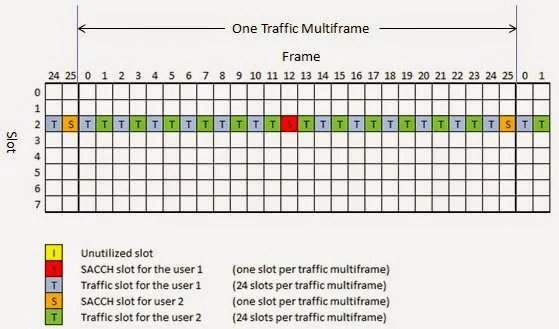
Figure 3: Multiframe
Control Multiframe
Unlike the traffic multiframe, the control multiframe is mostly used for network management, not user traffic. It has 51 burst periods over 235.4 milliseconds, making it longer than the traffic multiframe. This structure helps the network run smoothly and ensures devices can communicate with the system properly.
The control multiframe works on the beacon frequency, a special frequency used to send important network information. It contains channels like the Frequency Correction Burst (FCB) and the Broadcast Control Channel (BCH).
The FCB helps mobile devices stay in sync with the network's timing and frequency. This is important to avoid interference or dropped calls. The BCH sends system information to devices, such as location codes and network parameters, helps phones connect and move between network areas.
Together, these channels in the control multiframe make sure all devices stay in sync with the network and have the information needed to maintain a strong connection, even as conditions change. This allows users to move between different network areas while staying connected.
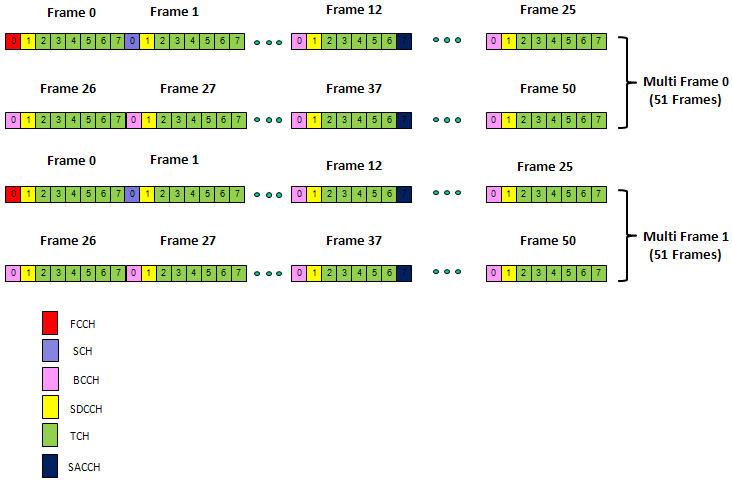
Figure 4: Control Multiframe
GSM Superframe
In the GSM (Global System for Mobile Communications) network, a superframe helps organize and sync communication. It is a unit that groups together multiple frames, improving how the network runs. A superframe includes either 51 traffic multiframes or 26 control multiframes, lasting 6.12 seconds. This structure ensures that information flows smoothly and in order.
The superframe helps coordinate both user data (like calls, messages, and internet) and control signals (like call setup and network management). By organizing these into a superframe, the GSM system keeps everything in sync, allowing for efficient data and control signal transmission.
Without it, communication could become disorganized, causing dropped calls or delays. The superframe ensures that all network functions follow a steady rhythm, preventing disruptions. The fixed 6.12-second duration also helps network operators plan resources effectively and maintain smooth service.
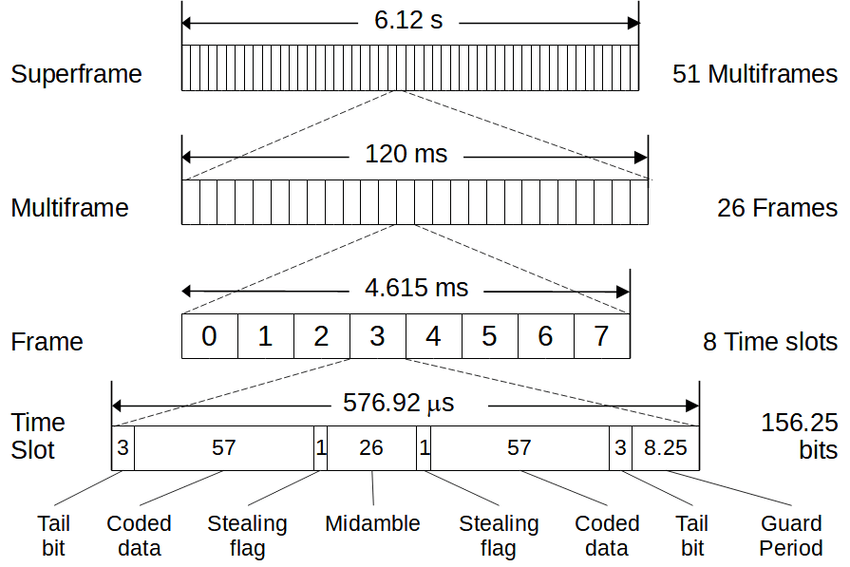
Figure 5: GSM Superframe
GSM Hyperframe
In the structure of GSM (Global System for Mobile Communications), the hyperframe is the largest time unit. It is made up of 2,048 superframes and lasts about 3 hours, 28 minutes, and 53.76 seconds. The hyperframe is a main part of how the GSM network keeps everything running smoothly, helping with important tasks like frequency hopping and encryption to keep communication secure and reliable.
Frequency Hopping
The hyperframe helps with frequency hopping, a method used to improve signal quality and reduce interference. This technique involves changing the communication frequency regularly so that signals don’t stay on one frequency for too long. This reduces the chances of interference and makes communication more reliable. The timing provided by the hyperframe ensures that frequencies change in a regular pattern, and also helps prevent eavesdropping.
Encryption and Security
The hyperframe plays an important role in GSM’s encryption, which protects communication data from being accessed by unauthorized people. The hyperframe helps keep the timing of the encrypted data in sync, so that encryption can work properly over long conversations or data sessions. If the timing gets off, it could weaken the security, so the hyperframe’s steady timing is great for maintaining privacy.
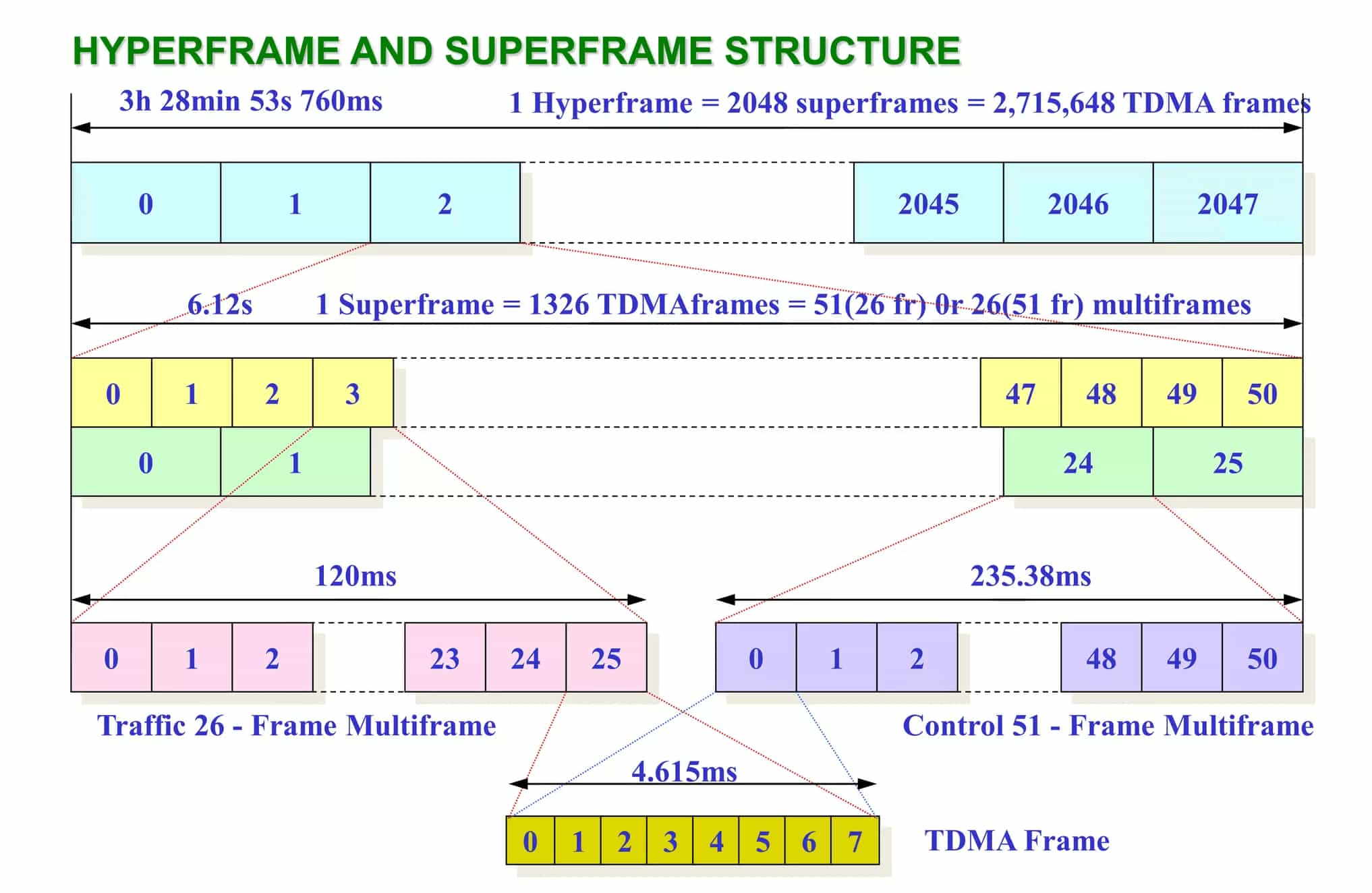
Figure 6: GSM Hyperframe
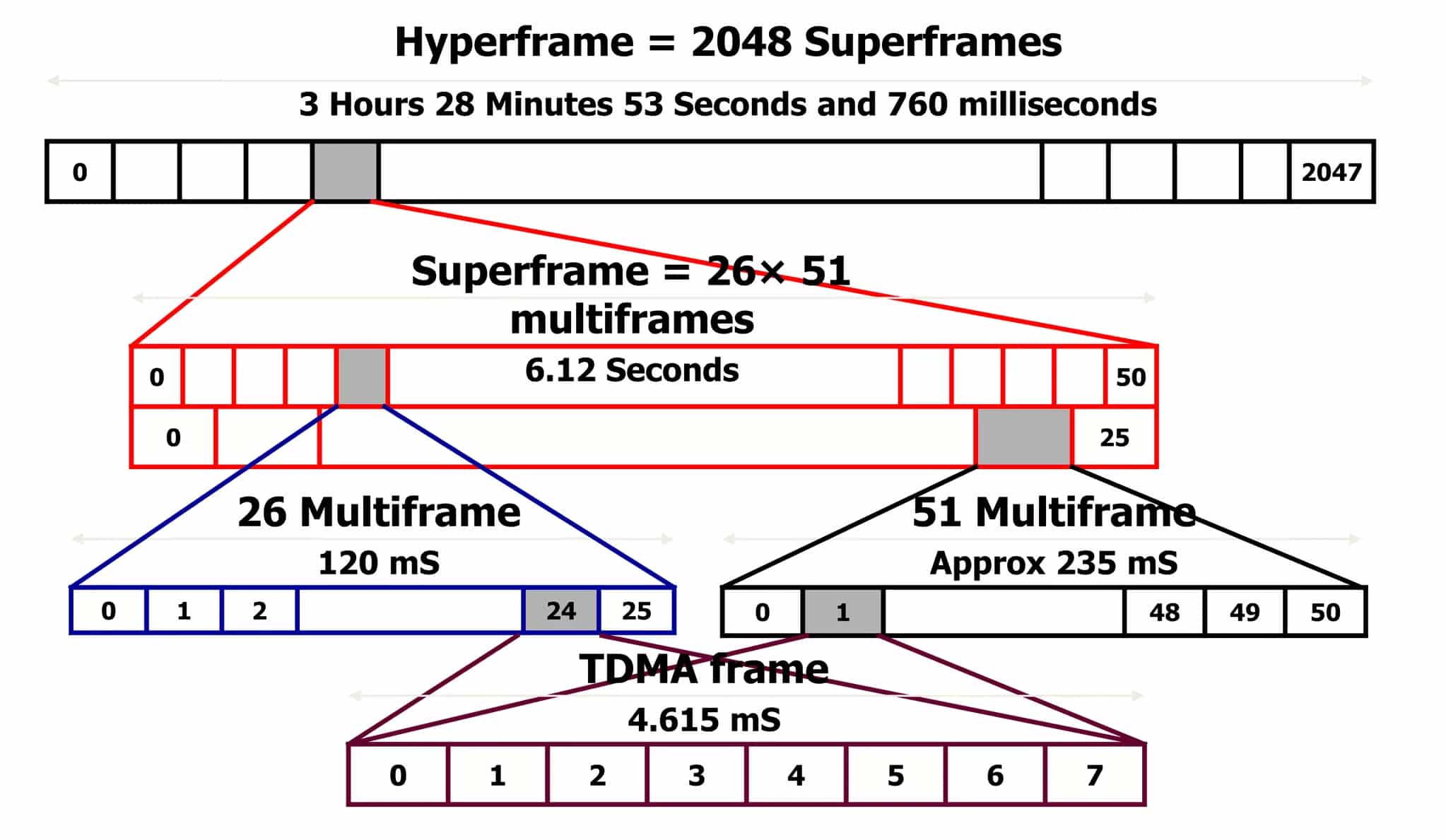
Figure 7: GSM Interface Cycles
GSM Frequency Bands
|
System |
Band |
Uplink (MHz) |
Downlink (MHz) |
Channel Number Range |
|
GSM-850 |
Band 5 |
824 - 849 |
869 - 894 |
128 - 251 |
|
GSM-900 |
Band 8 |
890 - 915 |
935 - 960 |
1 - 124 |
|
DCS-1800 |
Band 3 |
1710 - 1785 |
1805 - 1880 |
512 - 885 |
|
PCS-1900 |
Band 2 |
1850 - 1910 |
1930 - 1990 |
512 - 810 |
|
GSM-400 |
Band 14/15 |
450 - 480 |
450 - 480 |
259 - 293/306 - 340 |
|
GSM-480 |
Band 14 |
479 - 492 |
504 - 517 |
306 - 340 |
|
GSM-700 |
Band 12/13/14 |
703 - 748 |
758 - 803 |
512 - 810 |
|
GSM-850 (Ext.) |
Band 26 |
814 - 849 |
859 - 894 |
128 - 251 |
|
GSM-R |
Band 900 |
876 - 915 |
921 - 960 |
955 - 1023 |
|
ER-GSM |
Band 900 Ext. |
880 - 915 |
925 - 960 |
0 - 124 |
Applications of GSM Frame Structure
Call Handling
GSM organizes its frames to manage multiple voice calls at the same time by assigning different time slots and frequencies to each user. For every call, specific time slots are allocated within a frame, allowing several users to share the same frequency spectrum without interference. This method, known as time-division multiplexing, helps the network handle a large volume of calls while maintaining clear and uninterrupted connections.
SMS Transmission
Text messages, or SMS, are sent through the GSM network using control multiframes. These frames set aside particular time slots for SMS, ensuring messages are delivered promptly even when voice traffic is high. By reserving slots for SMS in the control channel, the network guarantees reliable and efficient message transmission without disrupting ongoing calls.
Mobility Management
Feature of GSM is its ability to manage user movement as people travel between different cell towers. When a user moves, the network uses control frames to handle the transition of ongoing calls or data sessions to a new base station. This process, known as a handover, is precisely timed to prevent dropped calls, allowing users to move across coverage areas without interruptions in service.
Security Protocols
Security in GSM is closely tied to its frame structure. The hyperframe plays an important role in maintaining secure communications by periodically resetting encryption and decryption keys. By updating these keys in sync with the hyperframe cycle, the network ensures that voice calls and data remain protected from unauthorized access, minimizing the risk of interception.
Conclusion
The GSM frame structure shows the advanced engineering behind global mobile communication. By organizing frames, multiframes, superframes, and hyperframes, GSM efficiently handles and synchronizes both data and voice across its network. This structure not only ensures smooth communication but also strengthens security with methods like frequency hopping and encryption. The way GSM manages different frequency bands shows its flexibility to work in various environments around the world. Understanding how these components work helps explain the complexity of mobile technology and highlights GSM's importance in modern telecommunications. As technology grows and network demands increase, the basic ideas in the GSM frame structure will continue to shape future mobile communication systems.
Frequently Asked Questions [FAQ]
1. What is the channel structure of GSM?
The Global System for Mobile Communications (GSM) employs a combination of frequency division multiple access (FDMA) and time division multiple access (TDMA) for channel structure. In FDMA, the entire frequency spectrum available for GSM is divided into 124 carrier frequencies spaced 200 kHz apart. Each of these frequencies is then further divided using TDMA, where each frequency channel is split into eight time slots. Each time slot represents a different channel used by a different user. This structure allows multiple users to share the same frequency without interference by allocating specific time slots for their signals.
2. What are GSM and LTE differences?
GSM (2G) and LTE (Long-Term Evolution, referred to as 4G) differ in technology, speed, and functionality:
Technology: GSM uses a combination of FDMA and TDMA. LTE uses orthogonal frequency-division multiple access (OFDMA) for downlink and single carrier frequency division multiple access (SC-FDMA) for uplink.
Speed: LTE offers higher data rates, with peak download rates of up to 300 Mbps and upload rates of 75 Mbps, compared to GSM's maximum data speeds of about 114 kbps.
Network Architecture: GSM is a circuit-switched system that handles voice and data separately. LTE is entirely packet-switched and capable of handling voice and data over the same Internet Protocol (IP) based network, increases efficiency.
Latency: LTE networks have lower latency compared to GSM, enhancing the experience for applications requiring real-time data transmission, like online gaming or video conferencing.
3. What is the format of GSM?
GSM uses a data format that encapsulates voice into data packets for transmission over digital signals. Each GSM frame consists of 8 time slots, and each slot contains a burst of data. The standard data format for a GSM message includes synchronization information, encoding data, and user data, facilitating communication between the network and the mobile device. This format ensures efficient use of the spectrum and synchronization of the multi-user access.
4. Does 5G use GSM?
No, 5G technology does not use GSM. 5G is built on new radio frequencies and a new network architecture designed to improve speed, capacity, and latency over previous cellular generations. It uses technologies such as massive MIMO, beamforming, and more advanced access technologies that differ from GSM’s FDMA/TDMA-based system.
5. Is GSM analog or digital?
GSM is a digital cellular technology. It digitizes and compresses data, then sends it down a channel with two other streams of user data, each in its own time slot. GSM was designed to replace older analog first-generation (1G) networks, thus providing better data security, higher quality voice transmissions, and support for text messages and data services.